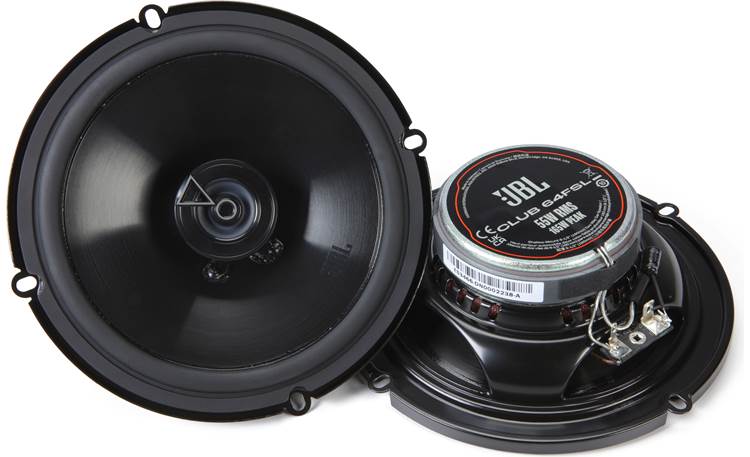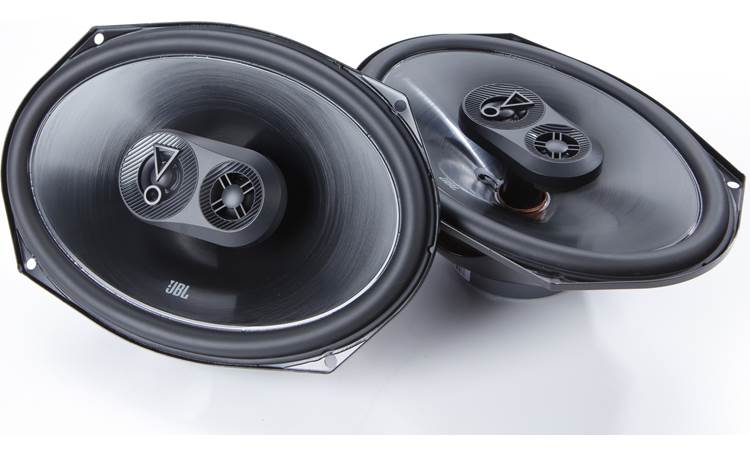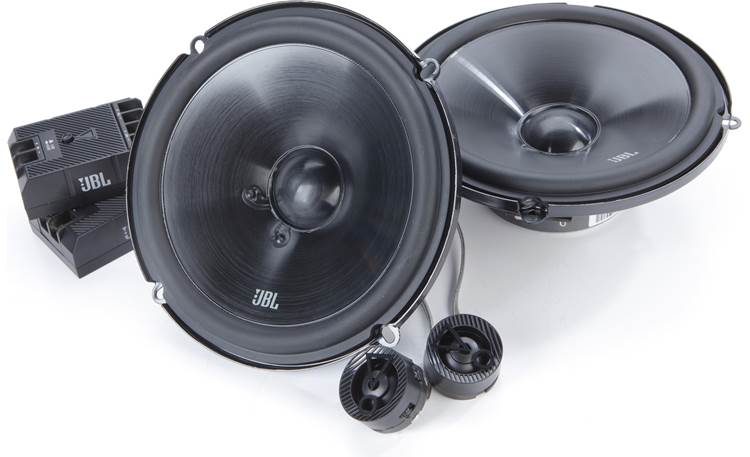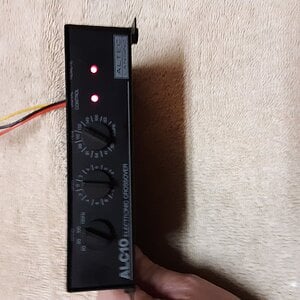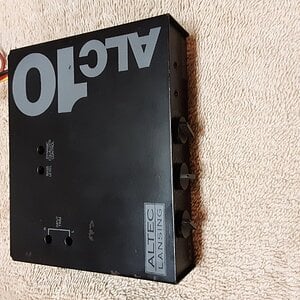I need some help on if I can still recover my car speakers or if at this point it is not worthwhile and I should look for replacements. I'm definitely a newbie with all of this. I apologize for the length of the post - I wanted to give all the details that might be necessary. I'm hoping some of you are patient enough to read through and help me out!
In short one of the rear speakers started rattling when playing bass. A guy at the local store said they were "blown" but without going into detail I wasn't sure he was well informed, and when I started researching on my own I found some issues.
I have these JBL speakers in the back deck:

They are component speakers - a sub with another speaker in that plastic bracket across the top. They are apparently 2 Ohm speakers, which makes finding replacements harder (and more expensive). In my search I found out about re-foaming them with a kit like this:

I wasn't sure if a re-foam would fix the issue, so first I tore apart my rear deck to get at the speakers. I could clearly see that the foam was highly deteriorated on the one speaker, with large pieces just flapping. The other speaker had some deterioration, but not as much and still seemed to sound ok. Since I figured I would need to refoam both, I started slowly pulling away some more foam off the good sounding speaker. It was so deteriorated it peeled away very easily and once I took off some more it started sounding just like the other speaker. I thought for the $25 for the re-foam kit it was worth trying to repair them. This is what they looked like before the re-foam:

I followed the instructions in the kit to remove all the foam and clean it all up. I think I did a good job getting it off the metal housing and the speaker cone. When the foam was removed there was a gap between the metal and cone. This is not my speaker, but taken from online as an example of what I'm talking about:

I had read something about having to possibly "shim" the speaker and/or remove the black piece in the middle of the cone (don't know what its called!), however the entire cone seemed to be one piece and not something that should be removed. The cone did not shift at all inside the assembly, at least not left to right. It moves up and down (mostly down if you compress it), but since it didn't appear to move freely in its housing it, and because none of the tutorials I found said so, it seemed that you could just affix the foam to both surfaces.
The instructions stated to glue the foam to the cone first and after it dried to apply the glue to the underside of the foam which affixes to the metal housing. I think I did a decent job with this, although with the foam covering the cone it was hard to know if it was 100% even on all sides. For example:

In the above picture the yellow ring is the edge of the attached foam. You can see that it is adhered to the entire ring, but where the yellow line points there is a bit more cone (meaning the foam here would be adhered a little closer to the center of the speaker), whereas the edge affixed near the red line is closer to the outside of the cone. The above is probably an exaggeration and my centering may have been off by a mm or two. But, since I adhered the cone first, the outside edge of the foam still fit comfortably back around the housing .
I'm just mentioning all of this because the instructions didn't really call for any special care to make 100% everything was lined up to the mm. I tried the best I could, but the glue dries fast and I didn't want to peel stuff back and ruin it even more and have to buy additional pieces.
So - I put these back into the car after they dried. At first I heard some rattling which I thought was due to the speakers not being mounted to the deck tight enough. They were attacked with metal bolts that simply screwed through the speaker housing and the deck of the car. However some of the bolts would not tighten anymore (because the metal hole in the deck was now too loose), so I went at bought some nuts to put on the underside (in the trunk) to tighten them better to the frame. I thought this worked and when blasting the bass it sounded ok, but I soon realized the loud reverb was hiding the issue.
When I have the volume set pretty low, I can now hear that one of the speakers (unfortunately I can't identify which speaker was which from when I removed them, they got moved around) still makes a buzz/rattle on bass.
I played around pushing down on the edges of the cone in various positions and determined if I either put some pressure from above on one side (or pull the opposite side down from the underside of the cone in the trunk) the sound is reduced or eliminated.
I tried to place some wound cloth around the edge of the housing to put pressure on the spot and it does the trick...until the volume is turned loud and the movement of the speaker shakes it loose.
I don't know if the speakers can be repaired easily. I feel like I did a good job with the re-foam and I don't think I would know how to do it better if my positioning of the foam ring being a little off center is the problem. From my observation it doesn't appear so because again the center cone doesn't shift around (only moves up and down). Also whatever slight pressure from the foam ring being off center doesn't appear to be enough to cause this.
I would think there is a solution to repair, seeing how only a wadded piece of cloth as an edge shim appears to help (or just pressing with my finger in a corner), but I don't know how convoluted it would be to repair.
Cost is an issue for me. This is an old car and I really don't want to put much money into it. New rear speakers which work with the current setup along with mounting hardware are likely to cost upwards of $300 just for low end.
I would appreciate any advice.
P.S: The speakers are mounted in the back now with the upper midrange also re-attached (with glue as it was previously) to the foam, so it is probably impossible to take them off without destroying the foam completely. I can however try to get any additional pictures and/or even a video of the issue if that will help at all.
In short one of the rear speakers started rattling when playing bass. A guy at the local store said they were "blown" but without going into detail I wasn't sure he was well informed, and when I started researching on my own I found some issues.
I have these JBL speakers in the back deck:
They are component speakers - a sub with another speaker in that plastic bracket across the top. They are apparently 2 Ohm speakers, which makes finding replacements harder (and more expensive). In my search I found out about re-foaming them with a kit like this:

I wasn't sure if a re-foam would fix the issue, so first I tore apart my rear deck to get at the speakers. I could clearly see that the foam was highly deteriorated on the one speaker, with large pieces just flapping. The other speaker had some deterioration, but not as much and still seemed to sound ok. Since I figured I would need to refoam both, I started slowly pulling away some more foam off the good sounding speaker. It was so deteriorated it peeled away very easily and once I took off some more it started sounding just like the other speaker. I thought for the $25 for the re-foam kit it was worth trying to repair them. This is what they looked like before the re-foam:
I followed the instructions in the kit to remove all the foam and clean it all up. I think I did a good job getting it off the metal housing and the speaker cone. When the foam was removed there was a gap between the metal and cone. This is not my speaker, but taken from online as an example of what I'm talking about:
I had read something about having to possibly "shim" the speaker and/or remove the black piece in the middle of the cone (don't know what its called!), however the entire cone seemed to be one piece and not something that should be removed. The cone did not shift at all inside the assembly, at least not left to right. It moves up and down (mostly down if you compress it), but since it didn't appear to move freely in its housing it, and because none of the tutorials I found said so, it seemed that you could just affix the foam to both surfaces.
The instructions stated to glue the foam to the cone first and after it dried to apply the glue to the underside of the foam which affixes to the metal housing. I think I did a decent job with this, although with the foam covering the cone it was hard to know if it was 100% even on all sides. For example:
In the above picture the yellow ring is the edge of the attached foam. You can see that it is adhered to the entire ring, but where the yellow line points there is a bit more cone (meaning the foam here would be adhered a little closer to the center of the speaker), whereas the edge affixed near the red line is closer to the outside of the cone. The above is probably an exaggeration and my centering may have been off by a mm or two. But, since I adhered the cone first, the outside edge of the foam still fit comfortably back around the housing .
I'm just mentioning all of this because the instructions didn't really call for any special care to make 100% everything was lined up to the mm. I tried the best I could, but the glue dries fast and I didn't want to peel stuff back and ruin it even more and have to buy additional pieces.
So - I put these back into the car after they dried. At first I heard some rattling which I thought was due to the speakers not being mounted to the deck tight enough. They were attacked with metal bolts that simply screwed through the speaker housing and the deck of the car. However some of the bolts would not tighten anymore (because the metal hole in the deck was now too loose), so I went at bought some nuts to put on the underside (in the trunk) to tighten them better to the frame. I thought this worked and when blasting the bass it sounded ok, but I soon realized the loud reverb was hiding the issue.
When I have the volume set pretty low, I can now hear that one of the speakers (unfortunately I can't identify which speaker was which from when I removed them, they got moved around) still makes a buzz/rattle on bass.
I played around pushing down on the edges of the cone in various positions and determined if I either put some pressure from above on one side (or pull the opposite side down from the underside of the cone in the trunk) the sound is reduced or eliminated.
I tried to place some wound cloth around the edge of the housing to put pressure on the spot and it does the trick...until the volume is turned loud and the movement of the speaker shakes it loose.
I don't know if the speakers can be repaired easily. I feel like I did a good job with the re-foam and I don't think I would know how to do it better if my positioning of the foam ring being a little off center is the problem. From my observation it doesn't appear so because again the center cone doesn't shift around (only moves up and down). Also whatever slight pressure from the foam ring being off center doesn't appear to be enough to cause this.
I would think there is a solution to repair, seeing how only a wadded piece of cloth as an edge shim appears to help (or just pressing with my finger in a corner), but I don't know how convoluted it would be to repair.
Cost is an issue for me. This is an old car and I really don't want to put much money into it. New rear speakers which work with the current setup along with mounting hardware are likely to cost upwards of $300 just for low end.
I would appreciate any advice.
P.S: The speakers are mounted in the back now with the upper midrange also re-attached (with glue as it was previously) to the foam, so it is probably impossible to take them off without destroying the foam completely. I can however try to get any additional pictures and/or even a video of the issue if that will help at all.
Last edited:


